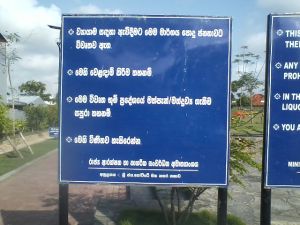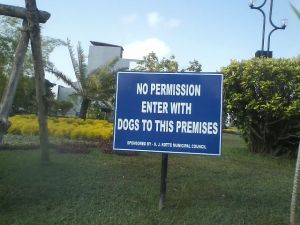The “leisure park” opened in the vicinity of Nugegoda Super Market junction along the Nugegoda-Nawala Road — a leisure giving initiative of the weirdly combined Ministry of Defense and Urban Development — is one of three modern “relaxation spaces” put up by the government, in a bid to modernize and modify suburban Colombo. While the uncritical masses and the apolitical classes are now the proud and awe-evoking commuters of a thriving and ever-growing “leisure culture” — a culture that has bred, if not multiplied, Colombo’s jogger community and its calory-walking syndicate — for the person with an average reflective capacity the enterprise is a microcosm of the hardline Gotafication of greater and Suburban Colombo.
Erected by, supervised by and maintained by the Military, the said leisure spaces simultaneously stand for a dialectic of “freedom” and “regimentation”. Or rather, one should state that what is offered to us in the spirit and guise of a modern liberal toffee — coated and couched in the promise of modern liberal socio-economic wrapping — is the cussed face of a totalitarian regime alone. The paradox of totalitarianism is well embedded in these leisure spaces, over which an overwhelming military presence can be felt. The park along the Nawala-Nugegoda road, in fact, is complete with a model military tank which sits propped right in the middle of the premises. The semiotic resonance of this military vibe is further enhanced by the presence of plain and uniform clothed cadres, militants in “worker kit” on all-around-the-clock maintenance and a suffocating number of signs and boards telling one what to do and what not to do at entering the park premises.
In fact, one should have a degree of nerve or a reasonable lack of conscience to enter the Nawala-Nugegoda “leisure space”. If you lack both, at least a decent sense of humour would do. The entrance to the park is an extension of the walkway itself, which has been suitably appropriated to take in vehicles from the main road. The first sign that comes our way indicates that the park premises has been set up for the “(physical) exercise purposes” of the commuters. It is quite alarming how the park-erector / maintainer decides exactly what form the community’s “leisure” should take; and as to underline “exercises” as the prerogative of one’s occupation of the park shows a regimental intent. The sign further prohibits any form of vendoring in the park premises and enforces a strict temperance code. After such democratically intriguing commands, a fourth presumptuous command orders the commuters of the park to “behave decently”.
 There are practical levels of tolerance that generally goes into one’s occupying of public spaces. For instance, if one considers the Botanical Gardens of Peradeniya — a lovers’ haven, a voyeur’s paradise and a sanctuary for a day out with friends or family — there are diverse groups with different agendas and priorities who flock there by the thousands every day. In addition, there are foreign and local tourists who come there and a slim minority who come there to check on the flowers and the trees, as well. As such, on a given day, the “leisure space” of the Peradeniya gardens accommodates pleasure-seekers of numerous forms whose ideas of “pleasure” and “leisure” remain self-defined — and thus appreciated — as long as accepted civilized mores and codes are not interrupted. One doesn’t put a board saying “behave decently”, as the regimental Ministry of Defense and Urban Development — an entity that has already placed within the park its own voyeurs — cannot be that presumptuous; leave aide being that serious. The prohibition of food and vendoring cannot be understood, as the leisure space culture in Sri Lanka (such as Galle Face Green, or a sports match for instance) has both these prohibited items at their center.
There are practical levels of tolerance that generally goes into one’s occupying of public spaces. For instance, if one considers the Botanical Gardens of Peradeniya — a lovers’ haven, a voyeur’s paradise and a sanctuary for a day out with friends or family — there are diverse groups with different agendas and priorities who flock there by the thousands every day. In addition, there are foreign and local tourists who come there and a slim minority who come there to check on the flowers and the trees, as well. As such, on a given day, the “leisure space” of the Peradeniya gardens accommodates pleasure-seekers of numerous forms whose ideas of “pleasure” and “leisure” remain self-defined — and thus appreciated — as long as accepted civilized mores and codes are not interrupted. One doesn’t put a board saying “behave decently”, as the regimental Ministry of Defense and Urban Development — an entity that has already placed within the park its own voyeurs — cannot be that presumptuous; leave aide being that serious. The prohibition of food and vendoring cannot be understood, as the leisure space culture in Sri Lanka (such as Galle Face Green, or a sports match for instance) has both these prohibited items at their center.
The park has limitations on bringing in pets and an overwhelming number of signs indicate that walls or parapets shouldn’t be stepped on or sat on. A lack of aesthetic sensibility or a conceptual depth in putting up “hazard” or “warning” signs make the whole place appear suffocating with signs right at the foot of the entrance itself. There’s a huge flat rock most unaesthetically and gaudily placed on which there is a pedantic and pompous declaration of the park being a “contribution till eternity” from the “eco-friendly” Mahinda Chinthana policy. To be curt, the entire engraving is a joke — if it is to be taken seriously — and is worth your time, if you happen to pass by the park in question.
The stone engraving has the names of Mahinda Rajapakshe — the Head of State and the person who opened the park for public consumption — and Gotabhaya Rajapakshe (the Secretary of Defense) which are carved in a slightly larger font and thereupon emphasized than the pedantic script, which forms the rest of the slab. Symbolically, the equal font face given to the two Rajapakshes represent the equal power and authority the duo shown to hold, as they are presented to the public’s eye. The park is a “mission” of the Ministries of Defense and Urban Development. In context, the “leisure park” chain is one instance of a booming Colombo with spaces and buildings which are “politically loaded” and “militarily stocked”. The high end malls along Reid Avenue, the Defense Services School in Slave Island and the relaid Racecourse are all the proud cousins of a “vibrant” public spirit ushered on the backs of a military resonance, of which the newly laid red bricks for the paved walkways of Colombo (a central agenda of the “beautification” of Colombo and the politicians’ pockets to whom the brick presses are commissioned) is the latest attraction.

